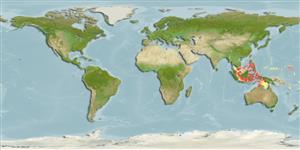>
Ovalentaria/misc (Various families in series Ovalentaria) >
Pseudochromidae (Dottybacks) > Pseudochrominae
Etymology: Pseudochromis: Greek, pseudes = false + Greek, chromis = a fish, perhaps a perch (Ref. 45335).
Environment: milieu / climate zone / rango de profundidad / distribution range
Ecología
marino asociado a arrecife; rango de profundidad 5 - 60 m (Ref. 90102). Tropical
Western Pacific: Philippines and Indonesia.
Tamaño / Peso / Age
Madurez: Lm ? range ? - ? cm
Max length : 6.5 cm SL macho / no sexado; (Ref. 48635)
Espinas dorsales (total) : 3; Radios blandos dorsales (total) : 25 - 26; Espinas anales: 3; Radios blandos anales: 14 - 15.
Body shape (shape guide): elongated; Cross section: compressed.
Found in coastal and seaward reefs in 5-60 m, solitary in caves or around rock outcrops (Ref 90102).
Life cycle and mating behavior
Madurez | Reproducción | Puesta | Huevos | Fecundidad | Larva
Lubbock, R., 1980. Five new basslets of the genus Pseudochromis (Teleostei: Pseudochromidae) from the Indo-Australian archipelago. Rev. Suisse Zool. 87(3):821-834. (Ref. 26137)
IUCN Red List Status (Ref. 130435: Version 2025-1)
Threat to humans
Harmless
Human uses
Herramientas
Special reports
Download XML
Fuentes de Internet
Estimates based on models
Preferred temperature (Referencia
123201): 27.7 - 29.1, mean 28.5 °C (based on 144 cells).
Phylogenetic diversity index (Referencia
82804): PD
50 = 0.5000 [Uniqueness, from 0.5 = low to 2.0 = high].
Bayesian length-weight: a=0.00501 (0.00193 - 0.01299), b=3.10 (2.88 - 3.32), in cm total length, based on LWR estimates for this (Sub)family-body shape (Ref.
93245).
Nivel trófico (Referencia
69278): 3.5 ±0.5 se; based on size and trophs of closest relatives
Fishing Vulnerability (Ref.
59153): Low vulnerability (10 of 100).
🛈
Nutrients (Ref.
124155): Calcium = 176 [85, 291] mg/100g; Iron = 0.861 [0.505, 1.473] mg/100g; Protein = 18.2 [17.1, 19.3] %; Omega3 = 0.117 [0.065, 0.211] g/100g; Selenium = 27.7 [12.2, 60.9] μg/100g; VitaminA = 159 [49, 508] μg/100g; Zinc = 2.24 [1.45, 3.22] mg/100g (wet weight);
